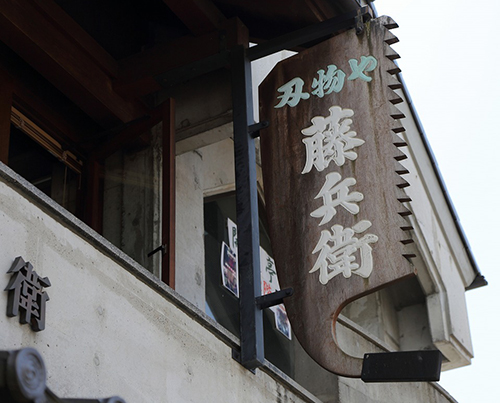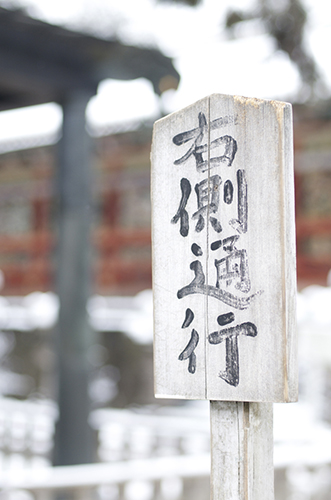144. The "Going" Radical: 行
Initially, the "going" radical 行 seems simple. This six-stroke shape has no variants and is quite familiar to us, thanks to this autonomous kanji:
行 (118: going; action; line of writing; party; auxiliary verb; bank)
Radical 144, 行, is on duty in that character, as well as in five more Joyo kanji:
衛 (617: guard, protection)
術 (708: technique; means)
街 (819: town; street)
衡 (1267: balance; equilibrium)
衝 (1411: to prick; prod; collide; attack; important)
As the 行 kanji carries six Joyo yomi, including ギョウ, い•く, and ゆ•く, the 行 radical can have these names:
ぎょう
ぎょうがまえ
いく
ゆきがまえ
The position name -がまえ (-構え) applies to radicals that enclose other components. (To learn more about this, see Radical Terms and look at the "Radical Positions" section, reading about Positions 5–7.) We find that enclosing arrangement in the last five of the six kanji with our on-duty radical. As for 行 itself, the simpler radical name ぎょう suffices.
English speakers can call 行 the "going" radical. Other options include "walk" and "journey."
So far, so straightforward. But there's one complication, as well as one cool aspect, as we'll soon see.

Photo Credit: Kayoko Kurimoto
In Kawagoe, a town in Saitama Prefecture on Honshu, the word across the top of this photo is 刃物や (はものや: edged tool shop), with the や standing for 屋 (shop). As the saw-shaped sign reflects, this store sells tools such as saws, planes, and chisels.
The 藤兵衛 (とうべえ) may be the founder’s given name.
"Going," "Going Person," or "Person"?
Here's where the going gets tough, or at least tricky. Nelson files only the 行 kanji under radical 144. As for the other five characters that I've placed in this category, he treats them all as if this radical matters instead:
彳 (radical 60: "going person")
To my surprise, Henshall says in his newer edition that 彳is an abbreviated form of the 行 radical, both meaning "move/road."
In terms of both nomenclature and appearance, our radical contrasts not only with 彳 but also with the following variant of 人 (radical 9: "person"):
亻, as in 仙 (1490: mythical being)
That variant is called にんべん, rendered in kanji as follows:
人偏 (にんべん: "person" radical) person + left-hand radical
In other words, にんべん means "'person' radical on the left side of a kanji." The word にんべん lies inside the name of radical 60, 彳:
行人偏 (ぎょうにんべん: "going person" radical) going + person + left-hand radical
The idea seems to be that 彳 is a 亻(にんべん)-like radical used in the 行 kanji (ぎょう).
Photo Credit: Corey Linstrom
Read the characters from right to left as 中華街 (ちゅうかがい: Chinatown). This is in Yokohama.
Split Down the Middle
We can compare 行 to other radicals on one more basis. That is, as you can see from the 街 (819: town) in the photo above, our radical splits apart and slides to the left and right, making room for a component in the middle. Except for the 行 kanji itself, all Joyo characters classified under radical 144 possess this feature.
Do any other radicals operate this way? The closest I can find is 臼 (radical 134: "mortar"), which plays a role in just one Joyo kanji—namely, 興 (652: fun). According to essay 1987 on 臼 (mortar), 臼 may not even be the radical in 興! Nelson says it is, but Henshall does not see 臼 as playing any part in this kanji. He maintains that the 臼 in 興 is part of a larger shape that once looked different and meant "lift up together."
Then what about 門 (radical 169: "gate")? Other shapes definitely fill the middle, as with 闇 (2121: dark), but the "gateposts" don't slide any farther apart in 闇 than they are in 門.
Somewhat like 門, whenever 戈 (radical 62: "tasseled spear") is on duty in characters, it accommodates other strokes inside. Take 戚 (2043: relatives), for instance.
Whereas 行 splits to the left and right, the strokes of 衣 (radical 145: "clothing") shift up and down in kanji such as 裏 (992: back) and 衰 (1456: to weaken). But the majority of characters featuring radical 145 don't follow this rule. I'm thinking, for example, of 製 (726: manufacturing) and 袋 (1546: bag).
Our 行 radical definitely stands out as unusual in this respect.

Photo Credit: Christopher Acheson
The word 右側通行 (みぎがわつうこう) means "(going) on the right-hand side," which contrasts with 左側通行 (ひだりがわつうこう: (going) on the left-hand side). These terms apply to both driving and walking. This sign may be telling people to keep to the right side of a corridor, staircase, or escalator.
Etymologies
What's going on with the "going" radical in various kanji? I've selected the interpretations from Henshall that afford the clearest "aha" moments:
行 (118: going; action; line of writing; party; auxiliary verb; bank)
This shape has evolved from the pictograph of "crossroads."
術 (708: technique; means)
The radical means "go," and the central portion phonetically conveys the associated sense "follow" or "bend, winding," depending on which scholar you believe. Overall, 術 represents "path" or "winding." The definitions "means, method" may be extended usage from the idea of following a path.
街 (819: town; street)
The radical means "go/crossroads," and the 圭 phonetically conveys the associated sense "join," making the whole character mean "roads which join." This later extended to "(busy) area" or "town."
